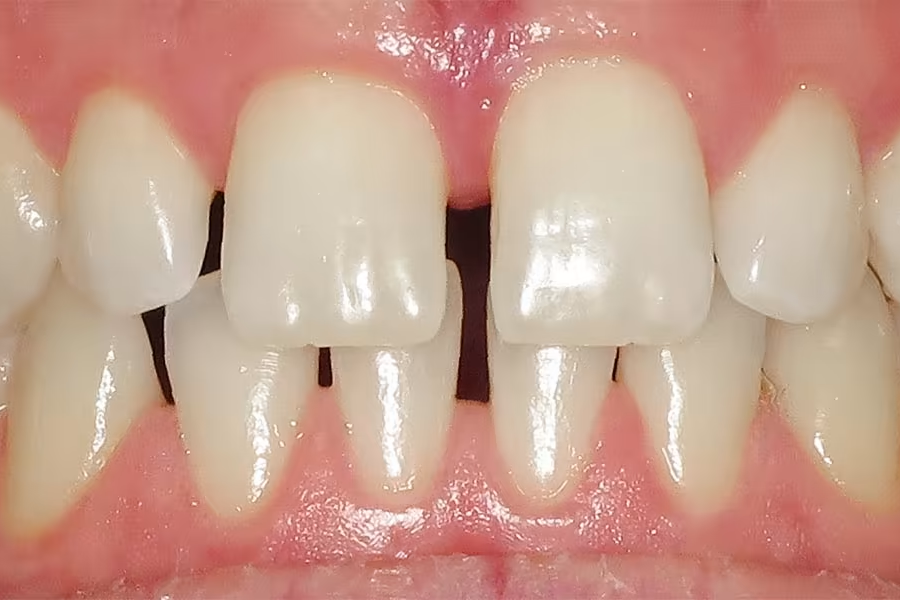Gaps between teeth, commonly known as diastema, can significantly affect your smile and self-confidence. Many individuals find themselves asking: “Can I fill teeth spacing, or do I need braces?” The answer to this question is not always straightforward; it depends on various factors, including the size of the gaps, their underlying causes, and your personal preferences. This article will explore your options for addressing diastema, helping you determine the best course of action for your dental needs.
Understanding Teeth Spacing: What is Diastema?
Teeth spacing, or diastema, refers to the abnormal space that occurs between two or more teeth. While it often appears between the upper front teeth, diastema can occur anywhere in the mouth. This condition can significantly impact the aesthetics of your smile, leading some individuals to feel self-conscious about their appearance. Understanding the underlying causes of diastema can help you decide the best treatment options available.
Causes of Teeth Gaps: Why Do They Happen?
Teeth gaps can arise from various factors, and understanding these causes is crucial for determining the right treatment. Some common reasons for diastema include:
- Genetics: Diastema can run in families, suggesting a hereditary tendency towards larger gaps between teeth.
- Size Discrepancies: An improper balance between the size of the teeth and the jaw can create gaps. If your teeth are too small for your jaw, spaces can develop.
- Tongue-Thrusting: This habit, where the tongue pushes against the teeth during swallowing or speaking, can create spacing issues over time.
- Thumb-Sucking: Similar to tongue-thrusting, prolonged thumb-sucking in childhood can lead to gaps between the front teeth.
- Gum Disease: Conditions like periodontal disease can lead to gum recession, which may cause teeth to appear spaced apart.
- Missing Teeth: If a tooth is lost and not replaced, neighboring teeth may shift into the gap, creating more spaces.
Do I Need to Fix Teeth Gaps?
Not all teeth gaps require treatment. Some individuals embrace the look of diastema, viewing it as a unique feature that adds character to their smile. However, in certain cases, diastema can lead to oral health issues, including:
- Improper Bite Alignment: Gaps can interfere with the proper alignment of teeth, leading to bite problems.
- Chewing Difficulties: Significant gaps may hinder effective chewing, impacting your ability to eat.
- Increased Cavities: Spaces between teeth can trap food particles, increasing the risk of tooth decay and cavities.
If you experience any of these issues, it may be time to consider treatment options.
Can I Fill Teeth Spacing, or Do I Need Braces?
Filling Teeth Spacing: Can Bonding or Veneers Help?
If you’re looking to fill teeth spacing without resorting to braces, dental bonding or veneers might be suitable solutions. Both methods can effectively enhance the aesthetics of your smile by closing gaps between teeth.
Dental Bonding
Dental bonding is a procedure where a tooth-colored resin material is applied to the teeth, effectively filling in the gaps. This method is popular due to its simplicity and effectiveness, making it an attractive option for those with smaller gaps. Some benefits of dental bonding include:
- Quick Procedure: The bonding process is typically completed in a single dental visit, making it convenient for individuals with busy schedules.
- Minimal Tooth Reduction: Bonding requires minimal alteration to the natural tooth structure, preserving your tooth’s integrity.
- Immediate Results: Patients can see the results immediately after the procedure, enhancing their smile right away.
However, it’s essential to note that bonding may not be suitable for larger gaps or more complex dental issues.
Veneers
Veneers are custom-made shells, usually made from porcelain or composite resin, that are designed to cover the front surface of teeth. This option provides a more comprehensive solution for larger gaps or uneven teeth. Benefits of veneers include:
- Long-Lasting Solution: Veneers can offer a more durable and longer-lasting fix compared to bonding.
- Customized Appearance: Since veneers are custom-designed, they can help create a perfectly aligned smile, covering multiple gaps and reshaping uneven teeth.
- Enhanced Aesthetics: Veneers can significantly improve the overall appearance of your teeth, providing a beautiful and natural-looking smile.
However, veneers can be more expensive than bonding and require some tooth reduction before placement.
The Limits of Filling Gaps: When Do You Need Braces?
While dental bonding and veneers can provide effective cosmetic fixes, they may not address underlying alignment issues. If misaligned teeth cause the gap or if the spacing is part of a more extensive orthodontic problem, braces may be necessary.
Traditional Braces: A Time-Tested Solution for Teeth Spacing
Traditional braces have been a reliable solution for correcting teeth gaps for many years. They are particularly effective for larger or more complex cases. Braces work by applying consistent pressure to teeth, gradually shifting them into their proper positions. Treatment with braces can take anywhere from 12 to 24 months, depending on the severity of the spacing and overall bite alignment. Some advantages of traditional braces include:
- Effective for Complex Issues: Braces can address a wide range of orthodontic problems, including gaps, crowding, and bite issues.
- Permanent Solution: Once treatment is complete, the results are typically long-lasting, provided that patients follow up with retainers.
Invisalign: A Clear Alternative to Traditional Braces
Invisalign has emerged as a popular alternative to traditional braces for individuals seeking a more discreet treatment option. This method uses a series of clear aligners to gently move teeth into place. Some benefits of Invisalign include:
- Discreet Appearance: The clear aligners are virtually invisible, making them an attractive option for adults and teens concerned about the appearance of metal braces.
- Removable: Invisalign aligners are removable, allowing for easier cleaning and maintenance of oral hygiene during treatment.
- Comfort: Many patients find Invisalign aligners to be more comfortable than traditional braces, as they don’t have wires or brackets that can irritate the mouth.
How Long Do I Need to Wear Braces or Invisalign?
The duration of treatment varies based on the size and number of gaps, as well as any additional alignment issues. With traditional braces, most individuals need to wear them for 12 to 24 months. Invisalign treatments are typically quicker, averaging around 12 to 18 months. Your orthodontist will provide a more accurate timeline tailored to your specific case during your initial consultation.
Cost Comparison: Filling Teeth Spacing vs. Braces
The cost of treating teeth spacing can vary significantly based on the method you choose. Here’s a general overview of the cost for each option:
- Dental Bonding: Typically costs between $300 to $600 per tooth, depending on the complexity of the procedure.
- Veneers: Costs can range from $800 to $2,500 per tooth, depending on the material used and the complexity of the case.
- Braces: The cost for traditional braces usually falls between $3,000 to $7,000, depending on the type of braces (metal, ceramic, or lingual) and the length of treatment.
- Invisalign: The cost of Invisalign treatment generally falls within a similar range to traditional braces, typically between $3,000 to $7,000.
Maintaining Your Smile: Aftercare for Filled Teeth or Braces
After filling gaps with bonding or veneers, maintaining good oral hygiene is crucial to preventing staining or damage. Here are some aftercare tips:
- Regular Cleanings: Schedule regular dental cleanings to help preserve the appearance of bonding material and veneers.
- Avoid Staining Foods: Limit consumption of foods and beverages that can stain your teeth, such as coffee, tea, and red wine.
For those wearing braces or Invisalign, maintaining oral hygiene is even more critical to prevent tooth decay during treatment. Follow these guidelines:
- Brush Regularly: Brush at least twice a day, especially after meals, to keep your teeth and braces clean.
- Use Floss and Interdental Brushes: Flossing can be more challenging with braces, so consider using interdental brushes or floss threaders to keep your teeth clean.
What About Retainers? Keeping Your Teeth in Place After Braces
After completing braces or Invisalign treatment, wearing a retainer is often required to prevent your teeth from moving back into their original positions. Retainers help maintain the new alignment of your teeth and may be recommended to prevent gaps from reopening. Your orthodontist will provide specific instructions on how long and when to wear your retainer for the best results.
Which Option Is Right for You?
Ultimately, the decision between filling teeth gaps and getting braces depends on several factors, including the size of the gaps, your budget, and your long-term dental goals. If you’re looking for a quick cosmetic fix for minor gaps, dental bonding or veneers may be sufficient. However, for more extensive spacing issues or alignment problems, braces or Invisalign may be the best choice.
Consult Your Dentist or Orthodontist for the Best Advice
Before making any decisions, it’s always wise to consult with a dental professional. Your dentist or orthodontist can assess the condition of your teeth and recommend the best treatment options for your specific needs. They will also help you understand the long-term implications of each option, empowering you to make an informed decision.
Conclusion
Deciding between filling teeth spacing or opting for braces largely depends on the size of the gaps, the underlying cause, and your personal goals. While dental bonding and veneers offer quick, cosmetic fixes for minor gaps, braces or Invisalign are often necessary for more significant alignment issues. By working closely with a dental professional, you can find the solution that best suits your smile and ensures your long-term oral health.
Call to Action
Are you ready to explore your options for filling teeth spacing or determining if you need braces? Schedule a consultation with your dentist today to discuss your dental needs and take the first step towards a more confident smile!
“Stay informed with in-depth articles and unique perspectives at BangkokTribune.com.”



